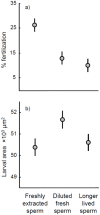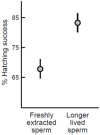Fertilization is not a new beginning: the relationship between sperm longevity and offspring performance
- PMID: 23155458
- PMCID: PMC3498328
- DOI: 10.1371/journal.pone.0049167
Fertilization is not a new beginning: the relationship between sperm longevity and offspring performance
Abstract
Sperm are the most diverse cell type known: varying not only among- and within- species, but also among- and within-ejaculates of a single male. Recently, the causes and consequences of variability in sperm phenotypes have received much attention, but the importance of within-ejaculate variability remains largely unknown. Correlative evidence suggests that reduced within-ejaculate variation in sperm phenotype increases a male's fertilization success in competitive conditions; but the transgenerational consequences of within-ejaculate variation in sperm phenotype remain relatively unexplored. Here we examine the relationship between sperm longevity and offspring performance in a marine invertebrate with external fertilization, Styela plicata. Offspring sired by longer-lived sperm had higher performance compared to offspring sired by freshly-extracted sperm of the same ejaculate, both in the laboratory and the field. This indicates that within-ejaculate differences in sperm longevity can influence offspring fitness - a source of variability in offspring phenotypes that has not previously been considered. Links between sperm phenotype and offspring performance may constrain responses to selection on either sperm or offspring traits, with broad ecological and evolutionary implications.
Conflict of interest statement
Figures



References
-
- Pitnick S, Hosken DJ, Birkhead TR (2009) Sperm morphological diversity. In: Birkhead TR, Hosken DJ, Pitnick S, editors. Sperm biology: an evolutionary perspective. Oxford: Academic Press. 69–149.
-
- Parker GA (1970) Sperm competition and its evolutionary consequences in insects. Biological Reviews of the Cambridge Philosophical Society 45: 525–567.
-
- Snook RR (2005) Sperm in competition: not playing by the numbers. Trends in Ecology & Evolution 20: 46–53. - PubMed
-
- Pizzari T, Parker GA (2009) Sperm competition and sperm phenotype. In: Birkhead TR, Hosken DJ, Pitnick S, editors. Sperm biology: an evolutionary perspective. Oxford: Academic Press. 207–245.
-
- Cornwallis CK, Birkhead TR (2007) Changes in sperm quality and numbers in response to experimental manipulation of male social status and female attractiveness. American Naturalist 170: 758–770. - PubMed
Publication types
MeSH terms
LinkOut - more resources
Full Text Sources

